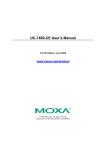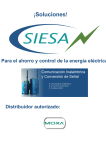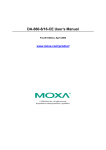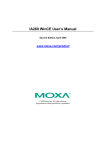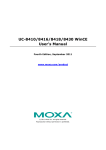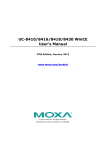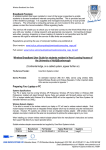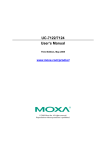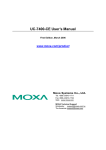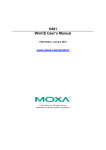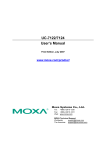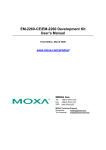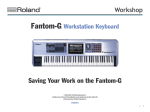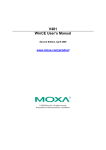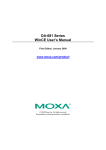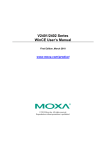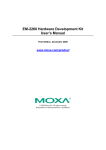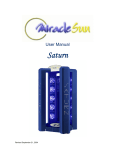Download UC-7400-CE User`s Manual
Transcript
UC-7400-CE User’s Manual Second Edition, July 2007 www.moxa.com/product Moxa Systems Co., Ltd. Tel: +886-2-2910-1230 Fax: +886-2-2910-1231 Web: www.moxa.com MOXA Technical Support [email protected] Worldwide: [email protected] The Americas: UC-7400-CE User’s Manual The software described in this manual is furnished under a license agreement and may be used only in accordance with the terms of that agreement. Copyright Notice Copyright © 2007 Moxa Systems Co., Ltd. All rights reserved. Reproduction without permission is prohibited. Trademarks MOXA is a registered trademark of The Moxa Group. All other trademarks or registered marks in this manual belong to their respective manufacturers. Disclaimer Information in this document is subject to change without notice and does not represent a commitment on the part of MOXA. MOXA provides this document “as is,” without warranty of any kind, either expressed or implied, including, but not limited to, its particular purpose. MOXA reserves the right to make improvements and/or changes to this manual, or to the products and/or the programs described in this manual, at any time. Information provided in this manual is intended to be accurate and reliable. However, MOXA assumes no responsibility for its use, or for any infringements on the rights of third parties that may result from its use. This product might include unintentional technical or typographical errors. Changes are made periodically to the information in this manual to correct such errors, and these changes are incorporated into new editions of the publication. Table of Contents Chapter 1 Introduction ..................................................................................................1-1 Overview.................................................................................................................................. 1-2 Model Descriptions and Package Checklist.................................................................. 1-2 UC-7400 Product Features ........................................................................................... 1-3 Product Hardware Specifications.................................................................................. 1-4 UC-7400-CE Software Features .............................................................................................. 1-5 Application Development Environment ....................................................................... 1-5 Networking and Communication Capabilities.............................................................. 1-6 Supporting Servers and Daemons................................................................................. 1-6 Learning Firmware Build Versions .......................................................................................... 1-6 Memory and File Systems ....................................................................................................... 1-7 RAM-based Storage ..................................................................................................... 1-7 Onboard Flash Memory Storage................................................................................... 1-7 External Media Storage ................................................................................................ 1-7 Caution When Storing Data.......................................................................................... 1-7 Storing Data in RAM vs. Flash Memory ...................................................................... 1-8 Hive-Based Registry ................................................................................................................ 1-8 Inserting a CompactFlash Card................................................................................................ 1-8 Installing a USB Mass Storage Device .................................................................................... 1-8 Installing a PCMCIA Card....................................................................................................... 1-9 RS-232/422/485 Serial Ports.................................................................................................... 1-9 Chapter 2 Getting Started .............................................................................................2-1 Starting the UC-7400-CE......................................................................................................... 2-2 Resetting the UC-7400-CE ...................................................................................................... 2-2 Operating the UC-7400-CE from the Serial Console............................................................... 2-2 Changing the Network Settings ............................................................................................... 2-2 Operating the UC-7400-CE by Telnet...................................................................................... 2-3 User/Group Management......................................................................................................... 2-4 Adjusting the System Time and RTC Time.............................................................................. 2-5 Troubleshooting Network Connectivity................................................................................... 2-6 Simple Network Management Protocol (SNMP)..................................................................... 2-7 Chapter 3 Web-based Management System ...............................................................3-1 Logging Onto Web-based Management System ...................................................................... 3-2 System Information.................................................................................................................. 3-2 Networking/Server Configuration............................................................................................ 3-3 Serial Port Configuration ......................................................................................................... 3-3 Process (Thread) Monitoring/Control...................................................................................... 3-4 Launching Processes Automatically ........................................................................................ 3-4 Services Monitoring/Control ................................................................................................... 3-5 Binary/Text File Management ................................................................................................. 3-5 Appendix A Programmable Function Keys and LCM ................................................... A-1 Appendix B Firmware Upgrade Procedure.................................................................... B-1 Appendix C Frequently Asked Questions ..................................................................... C-1 1 Chapter 1 Introduction Microsoft® Windows® CE 5.0 is an open, scalable, 32-bit operating system (OS) that is used to build a wide range of innovative, small footprint devices. Windows® CE-based devices are often designed for specific uses that run independently of other computers, or as a distributed front-end to a centralized host. Examples include enterprise tools, such as industrial controllers, communications hubs, and point-of-sale terminals. Other examples include display devices, such as HMIs, advertisement appliances, and interactive panels. MOXA’s Windows® CE computers were designed to meet the requirements of Windows® developers. We provide Windows® CE solutions for the MOXA UC-7400 series of ready-to-run embedded computers, including the UC-7420, UC-7410, and UC-7408. MOXA’s experience with developing embedded small footprint communication devices provides the intense technological skill required while porting the Windows® CE 5.0 kernel. The following topics are covered in this chapter: Overview ¾ Model Descriptions and Package Checklist ¾ UC-7400 Product Features ¾ Product Hardware Specifications UC-7400-CE Software Features ¾ Application Development Environment ¾ Networking and Communication Capabilities ¾ Supporting Servers and Daemons Learning Firmware Build Versions Memory and File Systems ¾ RAM-based Storage ¾ Onboard Flash Memory Storage ¾ External Media Storage ¾ Caution When Storing Data ¾ Storing Data in RAM vs. Flash Memory Hive-Based Registry Inserting a CompactFlash Card Installing a USB Mass Storage Device Installing a PCMCIA Card RS-232/422/485 Serial Ports UC-7400-CE User’s Manual Introduction Overview The MOXA UC-7400-CE Series (referred to in this manual as the UC-7400-CE) includes the UC-7420-CE, UC-7410-CE, and UC-7408-CE. These RISC-based ready-to-run embedded computers are ideal for embedded applications. The UC-7400-CE features 8 RS-232/422/485 serial ports, dual 10/100 Mbps Ethernet ports, 8 digital input and 8 digital output channels, a PCMCIA interface for wireless LAN communication, a CompactFlash port for flash disk expansion, and USB ports for adding additional memory (such as a USB flash disk). The UC-7400-CE uses an Intel XScale IXP-422 266 MHz RISC CPU. Unlike the X86 CPU, which uses a CISC design, the IXP-422’s RISC design architecture and modern semiconductor technology provide the UC-7400-CE with a powerful computing engine and communication functions, but without generating a lot of heat. The built-in 32 MB NOR Flash ROM and 128 MB SDRAM provide enough memory for running application software directly from the UC-7400. Since the dual LAN ports are built into the IXP-422 CPU, the UC-7400-CE makes an ideal communication platform for network security applications. If your application requires placing the UC-7400-CE at a site that is not located near an Ethernet LAN connection, you can connect to the network by using the UC-7400’s PCMCIA port to attach a wireless LAN card. The UC-7400-CE series of ready-to-run embedded computers use the Microsoft® Windows® CE 5.0 operating system (OS), which makes them suitable for new system development and legacy system migration. All of the necessary device drivers, such as a PCMCIA wireless LAN module and keypad, LCM, and buzzer control, are included with UC-7400-CE. The operating system, device drivers, and the software you develop for your own application can all be stored in the UC-7400’s flash memory. Model Descriptions and Package Checklist The basic features of each UC-7400-CE product are described below: UC-7420-CE RISC-based ready-to-run embedded computer with 8 serial ports, dual Ethernet ports, PCMCIA, CompactFlash, USB, WinCE 5.0 UC-7410-CE RISC-based ready-to-run embedded computer with 8 serial ports, dual Ethernet ports, WinCE 5.0 UC-7408-CE RISC-based data acquisition embedded computer with 8 serial ports, 8 DI channels, 8 DO channels, dual Ethernet ports, PCMCIA, CompactFlash, WinCE 5.0 The UC-7400-CE is shipped with the following items: y y y y y y y y y y 1 UC-7400 series embedded computer Wall-Mounting Kit DIN-Rail Mounting Kit Quick Installation Guide Document & Software CD Cross-over Ethernet cable CBL-RJ45M9-150: 150 cm, 8-pin RJ45 to male DB9 serial port cable CBL-RJ45F9-150: 150 cm, 8-pin RJ45 to female DB9 console port cable Universal Power Adaptor Product Warranty Booklet NOTE: Notify your sales representative if any of the above items is missing or damaged. 1-2 UC-7400-CE User’s Manual Introduction UC-7400 Product Features y y y y y y y y y y y y Intel XScale IXP-422 266 MHz Processor On-board 128 MB RAM, 32 MB Flash ROM Eight RS-232/422/485 serial ports 8 digital input channels and 8 digital output channels (UC-7408 only) Dual 10/100 Mbps Ethernet ports USB 2.0 host for mass storage devices (UC-7420 only) PCMCIA, wireless LAN expansion (supports 802.11b/802.11g) CompactFlash for storage expansion (UC-7420/7408 only) LCM display and keypad for HMI (UC-7420/7410 only) Ready-to-run WinCE 5.0 .NET platform DIN-Rail or wall mounting installation Robust, fanless design UC-7420/UC-7410 UC-7408 The UC-7420-CE and UC-7408-CE have a PCMCIA slot and CompactFlash interface for wireless communication and flash storage expansion. In addition, the UC-7420-CE integrates two USB hosts, a USB device port, and an LCM display for mass storage capability and other uses. The UC-7408-CE, which does not have an LCM or USB port, features 8 digital input channels and 8 digital output channels, making it an ideal but cost-effective embedded computer for data acquisition systems. The UC-7410-CE is a low-cost, stripped-down version of the UC-7420-CE designed for smaller-scale applications. As such the UC-7410-CE does not have a PCMCIA slot, CompactFlash, or USB port. Please see the comparison table below for more details about these products. 1-3 UC-7400-CE User’s Manual Introduction Product Hardware Specifications CPU RAM Flash LAN Serial Ports Serial Protection Data Bits Stop Bits Parity Flow Control Speed Serial Console DI/DO USB 2.0 Hosts USB 1.1 Client PCMCIA Storage Expansion LCM Keypad Real-time Clock Buzzer Reset Button UC-7420 UC-7410 UC-7408 Intel XScale, Intel XScale, Intel XScale, IXP-422 266 MHz IXP-422 266 MHz IXP-422 266 MHz 128 MB 128 MB 128 MB 32 MB 32 MB 32 MB Auto-sensing 10/100 Mbps × 2 with built-in 1.5 KV magnetic isolation protection, RJ45 connector RS-232/422/485 × 8, RS-232/422/485 × 8, RS-232/422/485 × 8, RJ45 connector RJ45 connector RJ45 connector 15 KV ESD for all signals 5, 6, 7, 8 1, 1.5, 2 none, even, odd, space, mark RTS/CTS, XON/XOFF, RS-485 ADDC™ 50 bps to 921.6 Kbps RS-232 × 1, RS-232 × 1, RS-232 × 1, RJ45 connector RJ45 connector RJ45 connector N/A DI × 8, DO × 8 N/A 2 N/A N/A 1* 1* 1* Cardbus × 1 N/A Cardbus × 1 Compact Flash × 1 ** N/A Compact Flash × 1 ** 128 × 64 dots 128 × 64 dots N/A 5 5 N/A Yes Yes Yes Yes Yes Yes HW Reset × 1, HW Reset × 1, HW Reset × 1, Reset to Default × 1 Reset to Default × 1 Reset to Default × 1 12 to 48 VDC 12 to 48 VDC 12 to 48 VDC 12W 10W 8W Power Input Power Consumption Dimensions 197 × 125 × 44 mm (W x D x H) 875 g Weight Operating Temperature Storage temperature Regulatory Approvals Warranty 5 years 197 × 125 × 44 mm 197 × 125 × 44 mm 810 g 870 g -10 to 60°C (14 to 140°F), 5 to 95% RH -20 to 80°C (-4 to 176°F), 5 to 95% RH EMC: CE Class A, FCC Class A Safety: UL, cUL, TÜV 5 years 5 years * The USB Client function is reserved for future enhancement. ** The CompactFlash is designed for a flash memory card or Microdrive. 1-4 UC-7400-CE User’s Manual Introduction UC-7400-CE Software Features The UC-7400-CE ready-to-run embedded computers are network-centric, head-less computers that are designed for programmed, embedded communication applications. The software features of the UC-7400-CE are described in the following subsections: Application Development Environment The Windows® CE environment of the UC-7400-CE provides users with a convenient, easy-to-use programming environment. The UC-7400-CE provides the following software features: y C Libraries and Run-times—Compared to the C libraries and run-times used on a desktop PC running Windows®, the C libraries and run-times on a UC-7400-CE are a subset of the WIN32 APIs. The C libraries support full ANSI C run time, standard input/output library, standard input/output ASCII library, and standard ASCII string functions. In addition, the C libraries support compiler C++ exception handling equivalency and Run-Time Type Information (RTTI) equivalent to desktop C++ compilers. y Component Services (COM and DCOM)—The Common Object Model (COM) is an operating system-independent, object-oriented system for creating binary software components that can interact with other COM-based components in the same process space, in other processes, or on remote machines. y Microsoft® Foundation Classes (MFC)—MFC is a comprehensive class library and complete object-oriented application framework designed to help build applications, COM components, and controls. y SOAP Toolkit—SOAP is an XML-based protocol for object exchange and remote procedure calls. Microsoft® Windows® CE 5.0 provides functionality similar to the SOAP Toolkit version 2 on the desktop. It provides a layer that allows COM objects to use SOAP as the transport protocol for remote procedure calls and to interact with Web services. y Microsoft® .NET Compact Framework 2.0—Offers a choice of languages (initially Microsoft® Visual Basic® and Microsoft® Visual C#) and eliminates the common problems faced with language interoperability. y XML—Provides the Document Object Model (DOM) for base XML functionality, support for XML Query Language (XQL) and XPATH, which are Extensible Style Sheet Language Transformations (XSLT) that enable you to transform one class of XML document into another class. In addition, SAX2 supports event-based parsing of XML documents and includes MSXML Writer, and parsing based on Simple API for XML (SAX) for resource-constrained target devices. y Winsock 2.2—Provides enhanced capabilities over Winsock 1.1, including installable service providers for additional third-party protocols, and Media sense. 1-5 UC-7400-CE User’s Manual Introduction Networking and Communication Capabilities For network-centric embedded application usage, the UC-7400-CE not only provides powerful communication hardware interfaces, including dual Ethernet ports and 3-in-1 serial ports, but also supports the networking and communications capabilities that are built into the Windows® CE 5.0 OS. The following features are supported: y Simple Network Management Protocol (SNMP)—Monitors remote connections to the network. y Simple Network Time Protocol (SNTP) Client—Provides support for synchronizing the device’s system time with an SNTP server, and supports Daylight Savings Time. y Serial Communications—In addition to the 16550 UART driver bound to a debug port and the console port, also included is a special driver for 8 additional MOXA serial ports. y Network Utilities (IpConfig, Ping, Route)—Utilities for troubleshooting various network problems. y TCP/IP—The protocols that are included are IP, Address Resolution (ARP), Internet Control Messaging (ICMP), Internet Group Membership (IGMP), Transmission Control (TCP), User Datagram (UDP), name resolution and registration, and DHCP. Supporting Servers and Daemons In addition to its development and communication capability, the UC-7400-CE also has the following embedded services and daemons. These common and easy-to-use application servers make it easy for users to migrate the UC-7400-CE embedded computer to industrial communication applications. y Telnet Server—Sample server that allows remote administration through a standard Telnet client. y FTP Server—Sample server used for transferring files to and from remote computer systems over a network using TCP/IP. y Web Server (HTTPD)—Includes ASP, ISAPI Secure Socket Layer support, SSL 2, SSL 3, Transport Layer Security (TLS/SSL 3.1) public key-based protocols, and Web Administration ISAPI Extensions. y Dial-up Networking—Includes the RAS client API and the Point to Point Protocol (PPP). RAS and PPP support Extensible Authentication Protocol (EAP) and RAS scripting. Learning Firmware Build Versions Three methods are available for obtaining the firmware version of the UC-7400-CE computer. You will need the firmware version to determine the precise features of your UC-7400-CE computer. y Examine the welcome message after you log on to the computer. y Log on to the web-based management system (described in a later chapter) to view the system information. y For the UC-7420-CE or UC-7410, you can obtain the firmware version by pressing the F1 function key, and then examine this information on the LCM display. 1-6 UC-7400-CE User’s Manual Introduction Memory and File Systems The UC-7400-CE file system allows file storage on the system RAM or on the onboard flash memory. Files can also be stored on external media such as a USB drive or CompactFlash card. RAM-based Storage About 20 MB of the 128 MB SDRAM is available for user applications and data. The operating system and kernel image occupy the rest of the space. The root directory is stored in RAM, along with subdirectories such as “Windows”, “Temp”, “My Documents”, “Network”, and “Program Files”. Files can be temporarily stored in these directories, but they will be deleted when the system is shut down or restarted. Persistent files and programs should be placed in the “NORFlash” directory. Onboard Flash Memory Storage Onboard flash memory storage is provided through the “NORFlash” directory. Anything that is saved in this directory will be retained when power is disconnected or lost. 15.5 MB of storage is available. The flash memory file system supports TFAT (Transaction-Safe File Allocation Table), which is safer than FAT. TFAT protects the file system from write corruption during critical events such as a sudden power loss. After a sudden power loss, the file state is rolled back. TFAT is a superset of FAT, which means that the embedded computer is able to mount external FAT file systems. External Media Storage When external media is installed, such as a USB drive or CompactFlash card, it will be found as an additional directory. For data that is intended to be shared with a PC, the external media should be formatted using the PC’s FAT file system instead of the TFAT file system. PCs may not recognize the TFAT format. Caution When Storing Data It is recommend that the onboard NOR flash be used for storing programs only. For log data generated by your programs, use external storage media such as CompactFlash or a Network File System. CompactFlash is much easier to replace if it is damaged or full. NOR flash memory has a life cycle of 100,000 write operations at the block (128 KB) level. It does not support BBM (Bad Block Management). For this reason, a FAT file system would not know if a flash block has reached the end of its life cycle. The FAT file system would continue to scan the block again and again, eventually resulting in an unpredictable state. In addition, the FAT file system searches for free space sequentially when performing write operations. As files are deleted, free storage space becomes more and more fragmented, making it difficult to search. When a file is frequently updated, data is deleted and rewritten to the same memory blocks over and over again. Eventually, the FAT file system would be unable to read those blocks, causing the operating system to hang. Although CompactFlash cards also have a life cycle, most use NAND flash memory with hardware controllers that implement BBM. This feature allows the FAT file system to flag and skip any bad blocks. Furthermore, there is much more storage space available on CompactFlash cards than on the NOR flash memory. This space can be used cautiously to maximize the media’s life cycle. An effective method is to create a large empty file (around 30 MB) to store log data. Data is written evenly over the space, and when the end of the space is reached, the write operations start over from the beginning of the space. This method reduces the number of write operations performed on each block. 1-7 UC-7400-CE User’s Manual Introduction Storing Data in RAM vs. Flash Memory Although data saved in RAM will be deleted when the system shuts down, RAM storage has the advantage of faster read/write access and no life cycle issue. For applications where important data is transmitted immediately and directly to a host, you can store the necessary log data in RAM. After the host receives the data, the data does not need to be retained and can be deleted. Embedded computers have resource limits, so integrators need to determine when it is critical that data be stored on one of the file systems. When it is necessary for data to be stored, the appropriate file system should be used. Hive-Based Registry The registry for the UC-7400-CE is a hive-based registry, instead of a RAM-based registry. The hive-based registry stores registry data inside files, or hives, which can be kept on any file system. This removes the need for performing backup and restore on power off. Inserting a CompactFlash Card The UC-7400-CE (except for the UC-7410-CE) is equipped with a type II CompactFlash slot that supports cards of both types I and II. Since mass storage cards are considered to be standard attachments, when an empty mass storage card is inserted in the slot, the computer automatically formats it in FAT format. Note that the formatting process takes a few minutes to complete. When a mass storage card is inserted, the UC-7400-CE creates a directory named “CFFloder” under the root directory. For programming purposes, use “CFFloder” to link to the directory. The following CompactFlash products have been verified compatible with the embedded computer: Manufacturer PRETEC SanDisk Ultra II Transcend Transcend Transcend Size 128 MB 1 GB 2 GB 2 GB 4 GB Speed 45X 80X 80X ATTENTION If your CompactFlash card is not detected when the system boots up, try the following: (a) Remove the CompactFlash card and insert it again. (b) Turn the embedded computer off and turn it on again. Installing a USB Mass Storage Device When an empty USB drive is installed on the UC-7420-CE, it will automatically be formatted using the FAT file system rather than the TFAT system. This is because USB drives are most often used to share data with PCs. Each USB drive will appear as a directory under the root directory, with the first device named “USBDisk” and the second device named “USBDisk2”. The following USB drives have been verified compatible with the embedded computer: 1-8 UC-7400-CE User’s Manual Manufacturer CRUZER Intel Abocom PQI Transcend Transcend Introduction Device Name mini Flash memory Size 128 MB 128 MB 128 MB 256 MB 512 MB 1 GB JetFlash JetFlash ATTENTION The system may not detect certain USB drives. We suggest that you use a USB drive that has been verified compatible with the embedded computer, as listed in the previous table. Installing a PCMCIA Card The UC-7420-CE does not have a built-in wireless card. If you install a PCMCIA wireless card, make sure that it has a WinCE5.0 driver. The following list shows PCMCIA Net Cards that have been tested successfully with the UC-7420-CE. Vendor Device Name Speed DFE-690TXD PCMCIA D-Link 10/100M Ethernet Card The UC-7420-CE should be work with most RTL8139 and NE2000 PCI PCMCIA cards. RS-232/422/485 Serial Ports The UC-7400-CE computer has a total of 10 serial ports, named COM1, COM2, …, COM10. COM1 is reserved for use by MOXA to test the firmware. COM1 is located inside the UC-7400-CE’s outer casing, and is not available to end-users. COM2 is the console port. COM2 provides users with a convenient tool for configuring the UC-7400-CE embedded computer. Although the console port is available for developing applications (such as data acquisition and control), we suggest that you use COM3 to COM10 to implement your data acquisition and control applications. COM3 through COM10 are 3-in-1 (i.e., RS-232, RS-422, and RS-485) serial ports designed to provide reliable, high-speed serial ports for a diversity of applications. Each ports supports a baudrate up to 921600 bps. 1-9 2 Chapter 2 Getting Started In this chapter, we show how to use a PC to operate your UC-7400-CE embedded computer. For clarity, the PC you use to connect to the embedded computer is called a development workstation, and the UC-7400-CE embedded computer is called a target computer. In addition, we explain operations such as system time adjustment, troubleshooting network connectivity, etc. Some of these operations can be done using system commands after gaining access to the computer, and others can be done using a web-based management system. The web-based management system is described in a later chapter. The following topics are covered in this chapter: Starting the UC-7400-CE Resetting the UC-7400-CE Operating the UC-7400-CE from the Serial Console Changing the Network Settings Operating the UC-7400-CE by Telnet User/Group Management Adjusting the System Time and RTC Time Troubleshooting Network Connectivity Simple Network Management Protocol (SNMP) UC-7400-CE User’s Manual Getting Started Starting the UC-7400-CE Connect the SG wire to the shielded contact located in the upper left corner of the target computer, and then power it on by connecting it to the power adaptor. It takes about 30 to 60 seconds for the system to boot up. Once the system is ready, the “Ready” LED will light up and remain lit until you shut down the computer. For a computer with an LCM display, the network address settings and other system information will appear on the LCM. Resetting the UC-7400-CE Warm/Cold Start: You seldom need to perform a warm start or cold start on the UC-7400-CE computer. In some cases when the computer stops responding, an application locks up, or when you upgrade the firmware, it may be necessary to perform a warm start or a cold start. Warm Start: In the power-on state, insert a pin into the “Reset” hole next to the serial ports and hold the pin in for 1 or 2 seconds. This will cause the computer to reboot. Cold Start: Switch off the power and then switch the power back on. The computer will reboot itself right away. Resetting to Factory Defaults: If the computer is not working properly, and you want to reset it back to the factory default settings, press and hold the “Reset to Default” button for at least 5 seconds. The buzzer will sound when the factory default settings are loaded. After the factory default settings have been loaded, the computer will reboot itself. Do not confuse this with the “Reset” button. Operating the UC-7400-CE from the Serial Console The serial console port (located next to the two LAN ports) gives users a convenient way of connecting the development workstation to the console utility of the target computer. This method is particularly useful when using the target computer for the first time. After connecting the serial cable, start a terminal program (e.g., HyperTerminal) from the development workstation by using the settings shown below for the serial console port. Baudrate Parity Data bits Stop bits Flow Control Terminal 115200 bps None 8 1 None VT100 After connecting successfully, type the login name and password when requested to log on to the computer. The default values are both admin. Login: admin Password: admin The console has a default timeout value of 15 minutes. To disable the timeout, you will need to change a value in the registry. Go to “HKEY_LOCAL_MACHINE\Comm\CONSOLED”, and set the “Timeout” value to “FFFFFFFF”. Changing the Network Settings The UC-7400-CE computer comes with two network interfaces. The default IP addresses and netmasks of the network interfaces are as follows: 2-2 UC-7400-CE User’s Manual Getting Started Default IP Address Netmask 192.168.3.127 255.255.255.0 LAN 1 192.168.4.127 255.255.255.0 LAN 2 For most applications, you will need to change the IP addresses and netmasks to accommodate the network environment. Use the netconfig utility to update the IP addresses and netmasks. Type netconfig -h to list the help items for this utility. \> netconfig -h Usage: netconfig –n <“LAN1” or “LAN2”> [-m <netmask>] [-d <DNS server>] [-g <gateway>] [-i <IP address>] For example, if your development workstation has a LAN port at 192.168.1.x and the Domain Name Server (DNS) is at 192.168.2.6, execute the following command: \> netconfig –n LAN1 –i 192.168.1.5 –m 255.255.255.0 –g 192.168.1.254 –d 192.168.2.6 Use the netconfig command to view the new settings. \> netconfig LAN1 Interface Configuration: IP Address: 192.168.1.5 SubNet Mask: 255.255.255.0 Gateway: 192.168.1.254 DNS: 192.168.2.6 LAN2 Interface Configuration: IP Address: 192.168.4.127 SubNet Mask: 255.255.255.0 Gateway: DNS: Operating the UC-7400-CE by Telnet Before operating your UC-7400-CE computer using the Telnet client, we suggest that you change the network settings of the computer (see the previous section) so that at least one of the two network ports is on the same LAN as your development workstation. Use a cross-over Ethernet cable to connect your development workstation directly to the target computer, or a straight-through Ethernet cable to connect the computer to a LAN hub or switch. Next, use a Telnet client in your development workstation to connect to the Telnet console utility of the target computer. After the connection has been established, type the login name and password as requested to log on to the computer. Login: admin Password: admin After logging in through the console port or a Telnet client, you will see a list of busybox commands available to operate the computer. Use HELP to display all of the commands, or type HELP [command name] to display extended help for the selected command. The DATE and TIME commands are used to manage the system time of the computer. Others commands, such as DIR and MKDIR, are used for file management. For example, to inspect the file structure of the root directory, type DIR \> dir /b NORFlash My Documents Program Files Temp Windows 2-3 UC-7400-CE User’s Manual Getting Started User/Group Management User Group: You should assign specific services, such as ftp and telnet, to defined user groups so that these services are accessible only by the users within the permissible user group. Three user groups, namely “ftpd”, “telnetd”, and “httpd”, are already created by default for your convenience. Adding a Group: Use the command useradd –g <groupName> to create a user group. \> useradd –g yyyy group yyyy has been added. Deleting a Group: To remove a group, use the command userdel –g <groupName>. \> userdel –g yyyy group yyyy has been removed. Adding a User: Use the command useradd <newUserID> to add a user that can access the system. By default, the user’s password is the same as the user name. \> useradd xxxx user xxxx has been added. In addition, you can permit this user to access a particular service by typing -g followed by the user group name of the service. I.e., useradd –g <groupName> <newUserID>. For example, \> useradd –g telnetd xxxx user xxxx is existent group telnetd is existent user xxxx has been added to group yyyy Deleting a User: Use the command userdel <userID> to delete a user from the system. The user “admin” CANNOT be deleted. \> userdel xxxx user xxxx has been deleted You can also just remove a user from a user group by using the command userdel –g <groupName> <newUserID>. For example, \> userdel –g yyyy xxxx user xxxx has been removed from group yyyy Changing the Password: Use the command passwd <userID> to change your login password. By default, the user’s password is the same as the user name. \> passwd xxxx Current password: New password: Retype new password: Password has been changed 2-4 UC-7400-CE User’s Manual Getting Started Adjusting the System Time and RTC Time The UC-7400-CE computer has two time settings: the system time (or CPU clock) and the RTC (Real Time Clock) time. The system time regulates the execution of instructions and the RTC keeps track of the time even when the computer is turned off. RTC time runs on a special battery that is not connected to the normal power supply. Do not confuse a computer’s real-time clock with its CPU clock. Setting the System Time Manually: Use the date, and time commands to query the current system date/time or to set a new system date/time. \> date The current date is: Tuesday, November 22, 2005 Enter the new date (mm-dd-[yy]yy): 12-23-05 \> date /T Wednesday, November 23, 2005 \> time The current time is: 5:27:17 PM Enter the new time (hh:mm:ss): 16:02:00 \> time /T 4:02:04 PM Adjusting RTC Time: Use the command hwclock -w to convert the system time to the RTC time. \> hwclock -w Use the command hwclock –w YYYY-MM-DD hh:mm:ss to update the RTC time manually. \> hwclock –w 2005-12-23 15:00:00 Use the command hwclock to query the updated RTC time. \> hwclock 2005-12-23 15:00:00 Starting and Stopping Services After booting up, the UC-7400-CE computer runs several services continuously to serve requests from users or other programs. Notable services include telnet (“TEL0:”), console (“CON0:”), world wide web HTTP (“HTP0:”), and file transfer FTP (“FTP0:”). You seldom need to deal with these services. However, you can start or stop a service with its associated name by using the command “services”. For example, Start the FTP service by typing: \> services start FTP0: Stop the FTP service by typing: \> services stop FTP0: The default services in the UC-7400-CE are: TEL0: Telnet Service FTP0: FTP Service CON0: Console Service 2-5 UC-7400-CE User’s Manual Getting Started Troubleshooting Network Connectivity The ipconfig tool prints the TCP/IP-related configuration data of a host, including the IP addresses, gateway, and DNS servers. \> ipconfig /all Windows IP configuration Ethernet adapter Local Area Connection: IP Address: 192.168.4.127 Subnet Mask: 255.255.255.0 Adapter Name: IXP425ETHNPE2 Description: IXP425ETHNPE2 Adapter Index: 2 Address: 80 86 33 33 34 12 DHCP Enabled: NO Ethernet adapter Local Area Connection: IP Address: 192.168.14.202 Subnet Mask: 255.255.248.0 Default Gateway: 192.168.15.254 Adapter Name: IXP425ETHNPE1 Description: IXP425ETHNPE1 Adapter Index: 3 Address: 78 56 34 91 cc dd DHCP Enabled: NO Host name: UC7420CE Domain Name: DNS Servers: 192.168.1.6 NODETYPE: 8 Routing Enabled: NO Proxy Enabled: NO Use the ping command to troubleshoot network connectivity, reachability, and name resolution. This command verifies IP-level connectivity to another TCP/IP computer by sending Internet Control Message Protocol (ICMP) Echo Request messages. The corresponding return Echo Reply messages are displayed, along with round-trip times. For more information, type ping without parameters. \> ping www.moxa.com Pinging Host www.moxa.com [192.168.1.16] Reply from 192.168.1.16: Echo size=32 time<1ms TTL=126 Reply from 192.168.1.16: Echo size=32 time<1ms TTL=126 Reply from 192.168.1.16: Echo size=32 time<1ms TTL=126 The route utility allows you to view or modify network routing tables. Type this command without parameters to view a list of functions. \> route To view current routing items in the tables, type: \> route PRINT To add a routing item on network interface 1, type: \> route ADD 192.168.0.0 MASK 255.255.0.0 192.168.15.254 IF 2 To delete a routing item, type: \> route DELETE 192.168.0.0 2-6 UC-7400-CE User’s Manual Getting Started Simple Network Management Protocol (SNMP) SNMP belongs to the TCP/IP protocol suite and is the Internet standard protocol for network management. SNMP was developed to monitor and manage networks. It uses a distributed architecture that consists of agents and managers: y The SNMP agent is an application that monitors network traffic. It responds to queries from SNMP manager applications. It also sends traps to notify the manager of significant events. y The SNMP manager is an application that sends queries to SNMP agents and receives traps from SNMP agents. The UC-7400-CE computer installs an SNMP agent to serve as an SNMP device. You should install the SNMP manager on the workstation computer (for example, a Linux system) that monitors the network. After installing the nodes, you need to configure the SNMP manager and agent. To check SNMP agent capabilities on a target UC-7400-CE computer (e.g, network IP address of 192.168.3.127), log on to the workstation (e.g., a Linux-based computer) on which the SNMP manager resides and then type: \> snmpwalk -v 2c -c public 192.168.3.127 system SNMPv2-MIB::sysDescr.0 Microsoft Windows CE Version 5.0 (Build 1400) SNMPv2-MIB::sysObjectID.0 SNMPv2-SMI::enterprises.8691.13.7420 SNMPv2-MIB::sysUpTime.0 1282929 SNMPv2-MIB::sysContact.0 Your System Contact Here SNMPv2-MIB::sysName.0 WindowsCE You will see a series of messages from the SNMP agent on the UC-7400-CE computer. You will then be able to monitor and manage the computer. 2-7 3 Chapter 3 Web-based Management System Note: Internet Explorer 5.5 and above is required to use the web-based management system. The UC-7400-CE ready-to-run embedded computers are network-centric platforms designed to be used as front-end computers for data acquisition and industrial control. Due to the distributed characteristics of the devices that these computers control, they often reside in harsh environments away from the system administrator. To manage these computers, operations such as networking/server configuration, file management, and process (thread) monitoring/control become a critical area to consider. The following topics are covered in this chapter: Logging Onto Web-based Management System System Information Networking/Server Configuration Serial Port Configuration Process (Thread) Monitoring/Control Launching Processes Automatically Services Monitoring/Control Binary/Text File Management UC-7400-CE User’s Manual Web-based Management System Logging Onto Web-based Management System A web-based management system is provided for the UC-7400-CE for easier management and system administration. The web-based management system uses a menu bar and CGI pages to provide access to commonly-used features. Before using the web-based management system, your PC must have a web browser installed and a network connection to the UC-7400-CE. To open the web-based management system, follow these steps: 1. Point your PC’s web browser to the UC-7400-CE’s IP address. When the main page opens, select Web-Based Management. 2. When prompted, enter the required authentication data, including case-sensitive user ID and password. The default user ID and password are as follows: User ID: admin Password: admin System Information After logging in, the main page displays the system information of the target UC-7400-CE computer, including the firmware version of the computer, the RTC time, the CPU system time, and system resources, including main memory and file system usage (RAM and Flash). 3-2 UC-7400-CE User’s Manual Web-based Management System Networking/Server Configuration The UC-7400-CE computer has two network interfaces. To view or change the interface settings, click the Networking link in the left menu bar. After the page loads, type the network parameters in the text input boxes and then click Update to activate the changes. Serial Port Configuration The embedded computer has multiple high-performance serial ports that can be set for RS-232, RS-422, or RS-485 operation. All serial ports are set to RS-232 by default, and serial ports can be set independently from one another. Changes will take effect when the system is rebooted, and will remain in effect until another change is made. 3-3 UC-7400-CE User’s Manual Web-based Management System Process (Thread) Monitoring/Control At runtime, the UC-7400-CE computer manages up to 32 applications. You can use the management system to monitor and control the applications. To view current processes, click the Processes item on the main menu bar. The processes that are running will be displayed. You can kill a process by clicking the “kill” button next to the process name. Launching Processes Automatically To have your application start on boot, do the following: Step 1: Click the “Processes” item on the main menu bar. In the lower part of the page, there is an area marked “Automatic Launching”. Step 2: Fill in the full path of the application in the first text field and its arguments in a separate text field if there are any. Step 3: Click “Add”. 3-4 UC-7400-CE User’s Manual Web-based Management System Services Monitoring/Control Some services run in the background to provide services, such as ftp or telnet, for user requests. To monitor and control these services, do the following: Step 1: Click the “Services” item on the main menu bar. The services that are running will be displayed. Step 2: Click on the appropriate check box to toggle a start/stop operation for a service. Binary/Text File Management When working from a PC, it is convenient to have a friendly window-based file manager to browse, delete, and organize files and directories. On the UC-7400-CE computer, such a convenient feature is simulated by the web-based management system. Just click “File Manager” to view the directory tree of your target UC-7400-CE computer. You can use the File Manager to perform the following operations: y y y y To browse a child directory, click the name of the directory. To delete a file, click the icon with the X in front of the file icon. To create a child directory, click Create Directory and then follow the instructions. To refresh the current directory, click Current Directory at the top of the page. 3-5 UC-7400-CE User’s Manual Web-based Management System In addition, the management system offers a mechanism for file upload. This mechanism helps you transfer files from your workstation to the target computer easily. For instance, after you have built an application on the development workstation, you can use this mechanism to upload the application to the current directory of the target computer. Step 1: Click “Upload File”. A browser window pops up. Step 2: From the pop-up browser window, click “Browse” to bring up a local file manager. Step 3: Browse to and select the file that you want to upload and click “open”. Step 4: Navigate back to the “File Upload” browser window, and then click “OK”. The file uploading starts. Step 5: After the file is uploaded completely, refresh the page. 3-6 A Appendix A Programmable Function Keys and LCM Notice: Only the UC-7420 and UC-7410 support LCM and Keypad functions In this appendix, we describe an internal service that is built around the function keys. This mechanism is designed to aid your applications in accessing these I/Os, but without needing to understand the complexity of I/O controls. Though this service gains controls on these programmable I/Os, it does not prevent you from developing them. Instead, we provide this mechanism for you to make it easier for you to develop your applications. This mechanism consists of a function key agent and a configuration utility. The agent operates based on five lists of pre-defined action items. Each list corresponding to a function key links a cyclic series of action items (10 at most) to be executed. The header item of this list maps directly to the first hit of the function key and then the next items follow. At the end of the list, the next hit circles the action back to the first item. A list without items comes with no action to be executed. Each action item can be in plain text or an application that you develop. The former is normally used for a reminder message, such as a manual for operating the function keys. The latter can be an LCM application. Nevertheless, this application is required to use the LCM APIs in our library mxdev.lib to transmit the variable text to the LCM. We have used this mechanism to implement an application on function key F1. When the key is pressed, the agent triggers this application to gather information and then displays the information on the LCM. The information includes the firmware version, network address settings, and current memory usage of the computer. These are particularly useful when you forget network information and have difficulties connecting to the computer. In addition, it provides an alarm system indicating the availability of your memory resource in the computer by preventing you from overusing your memory or losing data. To assist you in using this function key service for I/Os, the web-based management system also implements a utility to configure action items. To configure a plain text item, follow these steps: UC-7400-CE User’s Manual Programmable Function Keys and LCM Step 1: Log on to the web-based management system and select the “keypad-LCM” in the function area. The browser opens a page that shows five current sets of action items. Step 2: From the 5 sets of action items, choose one associated with a function key. Select the “Plain Text” option and then type the plain text into the text area. Step 3: Save the item by clicking the disk icon. To configure an application for a function key, follow these steps: Step 1: On your development PC, develop the application and make sure that it can output a multi-line text to the LCM display. Step 2: Use the web-based management system to upload the application to the target computer. Step 3: Select the “keypad-LCM” on the menu bar. The browser opens a page showing five current sets of function key action items. Step 4: Choose one set associated with a function key. Select the “App-Path” option and type the full path of the application into the text area. Step 5: Save the action item by clicking the disk icon. To disable an action item, simply click the icon with the X next to the item you choose. Be sure to heed the length of a text message. The leading text of a lengthy message is ignored. A-2 B Appendix B Firmware Upgrade Procedure Software features for MOXA embedded computers continue to be developed, improving quality and enhancing functionality. Firmware updates will be made available in the MOXA download center. When updating the firmware for your embedded computer, follow these instructions: 1. 2. 3. 4. Visit the MOXA download center at http://web4.moxa.com/support/download_center.asp to download the appropriate firmware update file for your embedded computer. This will be an executable file such as UC7420CE_V1_2.exe. Copy this file to the root directory (i.e., \) of your embedded computer. We do not recommend that you perform the update from a CompactFlash card or a USB drive, because performance will be very slow. Log onto the embedded computer using a Telnet or console connection. Execute the file. Enter “y” when prompted. UC-7400-CE User’s Manual 5. Firmware Upgrade Procedure The upgrade proves should take about five minutes. When the process is complete, you will be asked if you wish to keep the current network settings. Press “Y” to keep the current network settings. B-2 UC-7400-CE User’s Manual 6. Firmware Upgrade Procedure Enter “Y” when prompted to reboot the embedded computer. The system will be restarted with the new firmware in effect. B-3 C Appendix C Frequently Asked Questions Q: Can the connection port for the web server (HTTPD) be changed to something other than 80? A: Yes, you can change the connection port for the web server. This is accomplished by changing a registry setting. The following instructions show how to change the HTTPD port to 81 instead of 80. In this example, the embedded computer is assigned an IP address of 192.168.3.127. Adapt the procedure as necessary for your embedded computer’s IP settings. Step 1. Open Internet Explorer and point it the following IP address: http://192.168.3.127/sysadmin/?Client=IE4 If necessary, log on as an administrator. The default administrator user ID is “admin”, and the default administrator password is “admin”. Step 2. Select “Registry Editor” in the top frame. Step 3. Browse to “HKEY_LOCAL_MACHINE\Comm\HTTPD”. Step 4. Add a DWORD value named “Port”. The default value must be zero. For “New Value Name:”, enter “Port” For “New Value Type:”, select REG_DWORD Click the “New Value” button. Step 5. Change “Port” to 51 (81 in HEX). In the “Modified Value:” field, enter “51” Go to the display position for “Port” and then click “Modify”. Step 6. Browse to “HKEY_LOCAL_MACHINE\Services\HTTPD\Accept\TCP-80”. UC-7400-CE User’s Manual Frequently Asked Questions Step 7. Change the value of “SockAddr” to “02 00 00 51 00 00 00 00 00 00 00 00 00 00 00 00”. For “Modified Value:”, enter “02 00 00 51 00 00 00 00 00 00 00 00 00 00 00 00” Go to the display position for “SockAddr” and click “Modify”. Step 8. Log onto the embedded computer from a Telnet client and restart the web server. /> services stop HTP0: /> services start HTP0: Step 9. Try the new URL to verify that the change was successful: http://192.168.3.127:81/ Q: What type of file system is supported by MOXA embedded computers? A: MOXA embedded computers support TFAT (Transaction-safe File Allocation Table) file systems for the on-board flash memory. TFAT protects the file system from write corruption during critical events such as a sudden power loss. However, the TFAT file system may not be recognized by PCs. Therefore, MOXA embedded computers support the FAT (File Allocation Table) file system for external storage media such as USB drives and CompactFlash cards. Q: Where can I store files permanently on MOXA embedded computers? A: There is a sub-directory named “ORFlash” under the root directory. Use this directory to store persistent files. Q: Do MOXA embedded computer have a “C:\\” or “D:\\” directory as found on desktop PCs? A: MOXA embedded computers have a single root directory, “\”. Any external storage media will appear as subdirectories under the root directory, as follows: USB drives: “\USBDisk” and “\USBDisk2” CompactFlash cards: “\CFFolder” Q: Can I delete any Windows CE system files? A: No, you should not be able to delete any system files. Even if you somehow succeed in deleting the files, they will simply reappear when the system reboots. Q: Can I add other users besides “admin”? A: Yes, by using the command “useradd”. The command “userdel” can be used to delete users. Q: Is there a way control user access for each function service (FTP, Telnet,... ) A: Yes. Log onto the embedded computer with the “admin” account. Use the command “useradd” to create user groups and assign users to them. Three groups are already created by default: “administrators”, “telnetd”, and “ftpd”. C-2 UC-7400-CE User’s Manual Frequently Asked Questions Q: If I accidentally delete system files or corrupt the operating system, is there any way to recover the system or reset the embedded computer to factory defaults? A: If the embedded computer is behaving strangely or not working properly, you may reset it back to factory default settings. While the embedded computer is powered on, use a paper clip or pin to hold the “Reset to Default” button down for five seconds. This is a recessed button on the front of the unit. A buzzer will sound as the factory default settings are loaded. When the procedure is completed, the system will automatically reboot. At that time, the embedded computer will have rolled back to its original state as defined by the original registry database. Persistent files in the “NORFlash” directory will not be altered and should remain intact. Q: Can I reboot MOXA embedded computers remotely? A: Yes, MOXA embedded computers can be remotely rebooted. Log onto the embedded computer from a remote client and use the command “reboot” to reboot the system. Q: What type of CompactFlash device is supported by MOXA embedded computers? A: MOXA embedded computers have Type II CompactFlash slots. These slots support CompactFlash Type I and Type II mass storage devices. Q: What type of USB device is supported by MOXA embedded computers? A: MOXA embedded computers support USB 2.0 and 1.1 mass storage devices. If you cannot find the “USBDisk” directory, try unplugging the device and plugging it in again. Q: I plugged a USB drive into the computer, but I can not find the associated directory under the root directory. A: If you can not find the associated “USBDisk” or “USBDisk2” directory, try unplugging the device and plugging it in again. Q: On MOXA embedded computers, how do I set up an application to start automatically upon bootup? A: To start an application automatically on bootup, log into the web-based management system and complete the following steps: Step 1. Navigate to “Processes” and find the “Automatic Launching” section. C-3 UC-7400-CE User’s Manual Frequently Asked Questions Step 2. In the first text field, enter the full path of the application. In the second text field, enter any arguments, if required. Click “Add” Step 3. Repeat steps 1 and 2 to set up additional applications that will start automatically upon bootup. C-4 UC-7400-CE User’s Manual Frequently Asked Questions Q: How do I monitor processes on MOXA embedded computers? A: In the Telnet or serial console, you can execute “ps” to monitor current processes. In the web console, there is a “Processes” page. You can monitor processes and “kill” a pending application on the system. C-5



































